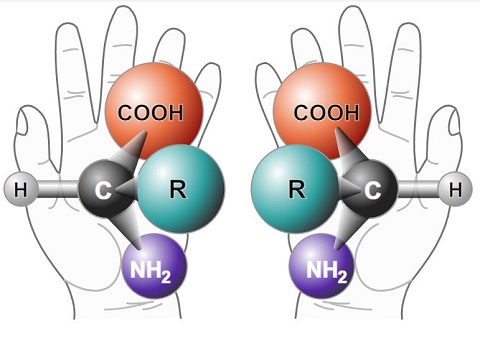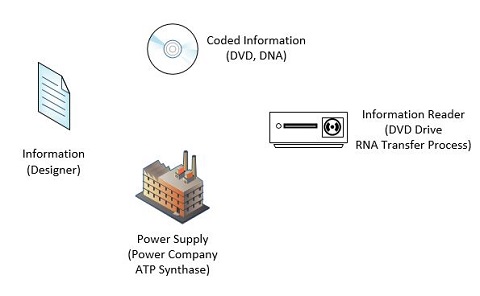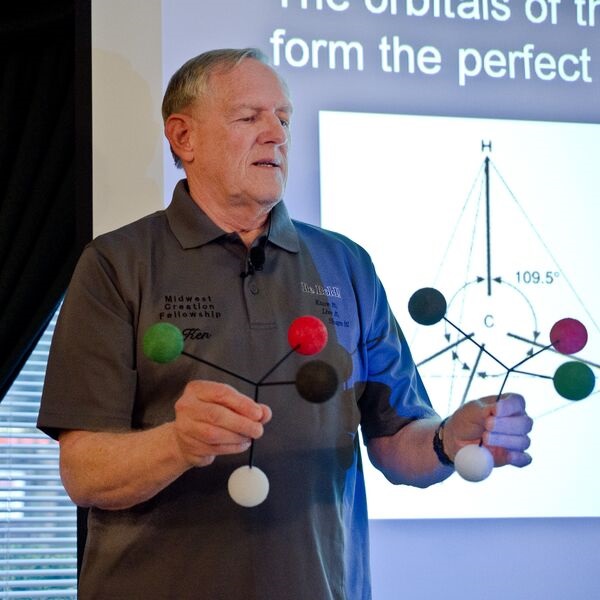
In the previous article I introduced the concept of chirality. Proteins are composed of amino acids and chirality is a property of those amino acids. To better understand how this is yet another concept that proves the impossibility of Darwinian evolution, we’re going to take a journey into the world of proteins and amino acids. Along with us on the journey, our tour guide and my featured guest: Dr. Kenneth Funk. Dr. Funk holds a Ph.D. in Organic (Peptide) Chemistry. He worked for 28 years as a synthetic organic chemist in peptide process development for Abbott Laboratories for 28 years. He is pictured above giving a talk on chirality and demonstrating how the orbitals of the four shared electrons of a carbon atom form the perfect shape of a tetrahedron. That shape is a perfect arrangement for creating chiral compounds. We’ll come back to shape. For the journey we’ll borrow Cosmos’ transport method: the ship of the imagination. Because “In this ship of the imagination, free from the shackles of space and time, we can go anywhere.”[1]
We’ll use the ship to help us focus on the fundamental building block of life: the cell. We’ll look inside the cell at the building blocks of proteins: amino acids – and then look at this key property called chirality. In the previous article I noted, “Molecules that are chiral are similar in that they are mirror images of each other, but not identical – like your hands.” Dr. Funk pointed out there’s more to the story than that, but to clarify, that was intended merely as a brief introduction, a placeholder until we could get to this article.
Having entered the cell we position the ship so we can get a closer look at a protein. Within the cell, a key component inextricably tied to the concept of chirality is proteins. Life, and the activity in these cells are both made possible by proteins. One cannot overstate the importance of proteins to life. To help put it in perspective I asked Dr. Funk:
“How important are these proteins that are created out of these specially sequenced, specially folded, amino acids? How important are they to life?”
Dr Funk: “[They are] critically important: while only 16% of the human body is protein, all of the functioning metabolic chemistry takes place with, by and for proteins. Structural proteins, enzymes, hormones, micro-molecular machines, cell membranes, etc., etc., are what drive life. No functional proteins, no life.”
Notice that key phrase: No functional proteins, No life. Let me emphasize a word within that key phrase: functional. That’s going to be critically important as we see these processes unfold. Because it’s possible to put together a number of different parts to look like something that performs a certain function – but if it doesn’t actually perform that function, it’s not a good replica or representation. For example you might find a mannequin that looks very realistic. But a mannequin is not alive, and does not have the internal systems that perform as do those of a living person, so it fails as a functional representative.
This is not a mere academic consideration. Evolutionists use such misdirection to defend the meritless theory of Darwinian evolution. Case in point: Michael Behe uses a mousetrap as an example of an irreducibly complex object that is designed. The point: All the parts must exist together, appropriately matched, (the parts must work together, with none too big, too small, too heavy, etc.) and assembled properly at the same time for it to work. They will not work separately for the stated purpose of catching mice. Evolutionist Ken Miller tried to refute both Behe’s concept of irreducible complexity and the mousetrap example by stating you could remove parts and the mousetrap could have other uses. For example you could remove the holding bar (which holds the spring back until the trap is tripped) and use the mousetrap as a tieclip. Two problems with that: First and foremost: without the holding bar, the remaining 4 parts are no longer useful as a mousetrap – so it fails its function. (As Behe put it, a trap in this state fails the criteria of “minimal function.”[2]) Second, there is no explanation as to what evolutionary forces could put those four components together. If you say some chic designer did it, then you’ve just refuted Darwinian Evolution! The point: if the item is not functional, it is not useful to evolution. (It’s also not useful to the living creature apart from evolutionary theories.)
Okay, with the importance of functionality understood let’s continue our journey. So Dr. Funk has told us “no functional proteins, no life.” Why are proteins so important? Douglas Axe, who has done much work on proteins and amino acids draws this analogy to explain:
“…if we liken a cell to a car, then the individual protein molecules within the cell are like the individual mechanical parts of the car – proteins are that crucial to life.”[3]
So clearly, no functioning proteins, no life. The next obvious question is how do you create a functioning protein? Let’s take our ship in for a closer look. Peering now at the protein, we see it consists of a sequence of amino acids that have been folded into a three dimensional (3-D) shape. To further explain:
Dr. Funk: “The primary structure – the sequence – is complete once the amino acids are assembled in order prescribed by the code.”
The “code” he is referring to is the genetic code contained within the cell’s DNA. Signature in the Cell author Stephen Meyer likens the DNA code to an information repository like a library.
“The organism accesses the information that it needs from DNA so it can build some of its critical components.”[4] He tells journalist Lee Strobel.
This CMI animation shows the process of amino acids being assembled in the prescribed order – starting at about 1:00 (minute)
Once the primary structure – the sequence of the amino acids – is completed, the sequence is folded into the necessary 3-D shape for the protein to work. Dr. Funk tells us this is a “complicated process with only superficial understanding of the how and why [it occurs].” That’s okay, because our focus is not on the shape of the protein, it’s on the shape of the amino acids. We’re going to take our ship a little closer to look at amino acids –
Chirality in Amino Acids
Moving in closer to look at the amino acids, perhaps first we should answer what is an amino acid? The dictionary defines an amino acid as “a simple organic compound containing both a carboxyl (—COOH) and an amino (—NH2) group.” “Organic compounds” are carbon-containing compounds associated with living organisms. Here is a picture of an amino acid that also shows its chiral property:
Dr. Funk tells me the shape of these amino acids make “non-superimposable mirror images.” To be more precise:
Dr Funk: “The stereochemistry of chiral amino acids and their assignment of absolute configuration is complicated. For the sake of this discussion, it is only important to know 19 of the 20 amino acids (the building blocks of proteins) come in two different geometric shapes commonly designated “left or right-handed”. All living cells, tissues and biological organisms and system utilize only “left-handed” amino acids in proteins.”
There’s a lot there so let’s unpack that. There are twenty amino acids. As illustrated in the picture above, amino acids can be considered “left handed” or “right handed” based on the geometry of the atoms in the amino acid. The circles in the depictions represent different atoms. Consider the geometric configuration of the circles. While the two amino acids are composed of the same atoms and function groups, they are not identical. If they were, when superimposed, one would completely obscure the other.
I made some very basic animations to further clarify this point. This first animation shows what you get if you attempt to superimpose the amino acid depicted on the left on top of the one depicted on the right:
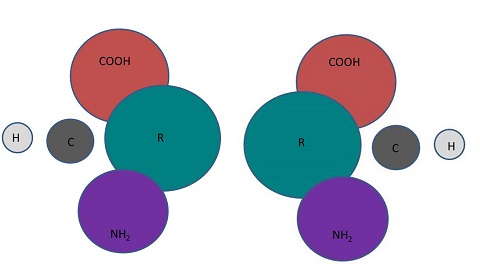
Superimposing a Left Chiral amino acid on top of a Right Chiral Amino acid
Since the shapes do not obscure one another they are not identical. But they are mirror images of each other. The property of chirality is apparent in your hands. (And hence the term. “Chiral” is derived from the Greek χειρ (cheir) which means hand.) That property can be made apparent with a mirror. If you put your hand up to a mirror, the image you get is identical to the hand you raised – but the structure of the image is reversed. So it is with chiral chemicals. So these “non-superimposable mirror images” are “geometrically different, but chemically the same” Dr. Funk points out.
If you can imagine turning the left amino acid over 180 degrees, as you might turn your left hand over from palm up to palm down, you’d get an arrangement as follows in the next animation:
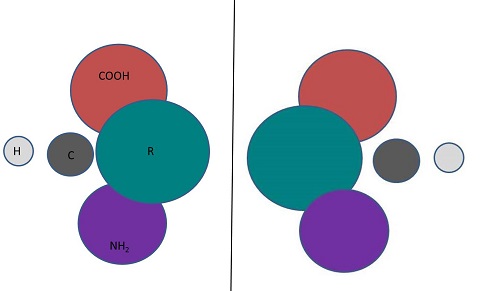
Mirror images – Reflecting opposite chiral amino acids show they’re chemically identical
In this case one does obscure the other when turned over to create a mirror image. So these amino acids are chemically the same, but geometrically different. The difference of the geometric layout of the above circles – which represent atoms in two amino acids – represent the difference that is referred to by the property of chirality. Amino acids are the components of the tens of thousands of different proteins in the body. Interestingly, in the human body, the amino acids that make up those proteins – all of them – are of the configuration referred to as “left handed.”
Well what difference does that make?
Dr Funk: “The genetic code codes for all one configuration, and the proper functioning of the micro-molecular machines like ATP synthesis, etc. would not function if one or more amino acid of the wrong geometric configuration were incorporated into the primary sequence because it would have a profound impact on shape.”
So the genetic code – the information in DNA – specifies that every amino that is used is a left handed amino acid. What happens if a right-handed amino acid is used you might wonder. Concerning that:
Dr: Funk: “Shape is critical for function. But to be technically correct a protein with a mixture of amino acids with differing geometries could theoretically fold into some secondary, tertiary or quaternary shape, but it would be non-functional within “left-handed” driven metabolism.”
Secondary, tertiary and quaternary shapes are protein shapes which we didn’t concern ourselves with above. But notice the key term we did spend some time on: Functionality. A protein with a right-handed amino acid would likely be rendered non-functional because it changes the critical property of the shape of the protein.
Why is it “non-functional?” What happens in the process if a right handed amino acid is somehow included?
Dr. Funk: “Translation halts.”
The CMI video above shows the translation process. You can see in that video that if the translation stops, the protein will be incomplete and thus non-functional. So there can be no right-handed amino acids in left-handed amino acid organized creatures. We’ve been talking about humans, but what creatures are encompassed by “left-handed amino acid organized creatures?”
Dr. Funk:
- All amino acids in the Human body are “L” or left-handed amino acids.
- All amino acids incorporated in living animal and plant tissue are “L” or left-handed amino acids
- DNA/RNA codes only for “L” or left-handed amino acids
- All proteins we eat, and digest are all “L” or left-handed
So essentially all living things are encompassed – not just humans. I immediately see two problems for secularists: How did that happen? It seems there are two options: Either by accident, or by some initial information code that specified it. But there are problems with each.
Evolutionists posit that the first life arose in some environment suitable to form these chemical structures like a primordial soup or alkaline thermal vents. That’s already a problem since water would tend to break down whatever chain of molecules tended to form – but that’s a separate problem. The problem we’re interested in is the problem caused by a racemic mixture of amino acids in the primordial soup. Dr. Funk explains:
“As soon as amino acids of differing chirality (geometric shape) were by chance (by chance because according to Darwinian processes – it’s a chance selection) included in the amino acid string attempting to polymerize into a future protein, that inclusion calls into question whether short peptides or longer proteins would form at all. And if one did form, it almost certainly would be an un-reproducible one because attempts to create a copy would fail with a translation mechanism similar to systems operating in cells today. So there would be no way to make another one under the proposed conditions of the primordial soup.” In short, such an amino acid would not be reproducible, and thus useless to the evolutionary scenario.
This is why in the previous paper I made the comment concerning 100 coins being tossed up and all landing up heads or all landing up tails. If you came across that, you’d say someone placed them that way. Now consider the primordial soup. If amino acids were generated by some random process as evolution requires – you’d expect a racemic mixture of left and right handed amino acids that will make a protein non-functional as soon as a right handed-amino acid was selected. On the other hand if you came across a primordial pond with billions of all left-handed amino acids, you’d say this is impossible, no random process did this – this is the work of an intelligent designer. Notice: either option kills the evolutionary scenario.
The other option is that somehow information came together to specify left handed amino acids. Well once you introduce talk about information – you’re talking about an intelligent designer, because as Meyer points out, “The creation of new information is habitually associated with conscious activity.”[5] But Dr. Funk notes the problem is deeper than just the origin of the information. In addition to the information, when you also consider the need for a machine to read the information, and the energy needed to run the machine to read the information, it’s a problem more complex than the proverbial chicken or the egg (which came first) problem:
Dr. Funk: “Yes, it is a chicken, egg and sun or electric spark problem which is more complicated than just the chicken and the egg. You have coded information, the need to read the information with a micro-molecular machine, you need energy to make the molecular machine go (which is the ATP generated [energy] from the micro-molecular machine) that needs the energy [it itself makes] to read the code to make itself.” Clearly this scenario is impossible by undirected, unplanned, unintelligent forces.
If I were to draw an analogy using computer concepts, it would look something like this:
First of all, there is the information which exists before any physical item. The information is a non-material concept (already a problem for secularists who believe in a material-only world.) That non-material information must somehow be encoded onto the DVD disk. (Instead of a disk, it’s DNA for the cell.) Notice this also means the creation and use of a code and an encryption process. Once it’s encoded, to use the information, you need a machine to read it, copy it, then write it. In a computer it’s your DVD burner. (Note: a DVD ROM (Read Only Memory) – the first version of the device that was released – is incapable of writing, so specific capability must be built in to a DVD device to write.) In the cell it’s the RNA transfer and transcription process. But like your DVD burner, that process requires energy to run. That energy must come from a power generator. Your DVD burner gets power ultimately from some previously designed, and constructed power plant that distributes power. In the cell it’s ATP synthase enzyme. But how did that micro-molecular machine get there?
Clearly like the power plant that powers your DVD burner, it too must have been previously designed and constructed. Further, it’s built from the information that’s encoded on the DVD disk. How did that information get read without the power plant existing to provide the energy to read it? And the burner also needs energy to operate and also needs information from the yet unread information in DNA. You (no doubt) see where this is going. The processes are mutually dependent on each other, and must all exist simultaneously, fully functional in their finished form to work. If not, you can’t read the information, you can’t write the information, and nothing works. Clearly a death blow to the evolutionary scenario.
This is another example of the problem of irreducible complexity, and it’s really just the tip of the iceberg of problems. Evolutionists still can’t identify the origin of the information that specifies the amino acid sequences – which is in DNA. Where does this initial information come from? They also have no explanation for how DNA – the most efficient information storage system in the universe – came about. They have no explanation for how or why a transcription process developed (remember undirected, unintelligent forces can’t have motives, it can’t choose to build one); or how and why an energy generation process consisting of an irreducibly complex micro-molecular machine developed. These problems are unsolvable in the secular paradigm of undirected, unintelligent forces acting over time.
Before leaving this topic, let me note that the above problems all center on the central problem of the origin of the information in DNA and how to read it and use it. Dr Funk pointed out a more basic problem I will feel remiss in if I don’t point it out: concerning the basic problem of chirality – the single-handed orientation of the amino acids in all life – the problem is this: secular science has no answer as to how it came about. He points me to an article by CMI scientist Dr. Jonathan Sarfati who has an article[6] that he updates as appropriate of the attempts to answer the problem. All the answers that secularists have offered (10 as of this writing) have failed.
Conclusion
There are many items that demonstrate that Darwinian evolution is impossible – I just finished listing 15 of them in the previous series. But this item – in and of itself – has so many avenues that deal a death blow to secular theories I can only marvel at the great, unfounded faith secular scientists have that one day, having spent billions of dollars searching via probes and radio telescopes, they’ll find intelligent life somewhere out there in the vast reaches of space. Given what we know about the origin of information and the impossibility of creating the needed processes to read it via evolution, I will predict (again) what I have predicted before: Scientists will not find life anywhere else in the universe. Scripture tells us it is the earth that God created to sustain life:
For this is what the LORD says– he who created the heavens, he is God; he who fashioned and made the earth, he founded it; he did not create it to be empty, but formed it to be inhabited– he says: “I am the LORD, and there is no other.
Is 45.18
There is no indication life exists anywhere else in creation, except in the heavens above, and the destruction that waits in the fires below for those who reject God’s gracious offer of life. I hope you exit our tour ship fully persuaded and convinced that the chiral nature of amino acids points to the only solution to the origin of life, which was revealed thousands of years ago: In the beginning, God created the heavens and the earth.
Duane Caldwell | October 17, 2020 | Printer friendly version
Follow @rationalupdates
Notes
1. Cosmos, A Space Type Odyssey – Episode 1 “Standing Up in the Milkyway”, Hosted Neil DeGrasse Tyson, Cosmos Studios, National Geographic Documentary, 2014
Back
2. Michael Behe, Darwin’s Black Box – The Biochemcial Challenge to Evolution, New York: Free Press, 1996, 2006, p. 45
Back
3. Douglas Axe, Undeniable – How Biology Confirms Our Intuition That Life Is Designed, (Kindle Ed.) New York: HarperOne, 2016, loc 480
Back
4. Stephen Meyer ref. from, Lee StrobelThe Case For A Creator, A Journalist Investigates Scientific Evidence That Points Toward God, Grand Rapids MI: Zondervan, 2004, p. 225
Back
5.Quastler,The Emergence of Biological Organization, 16; Referenced by
Stephen C. Meyer, Signature in the Cell, New York: HarperOne, 2009, p. 376
Back
6. Jonathan Sarfati, Journal of Creation (formerly TJ) 12(3):263–266, December 1998; Also available as:
“Origin of life: the chirality problem”, CMI, https://creation.com/origin-of-life-the-chirality-problem, first published 1998, updated 2010
Back
Images
Dr Ken Funk – Used by permission
Chirality with Hands / Public domain
Superimposition of Chiral Molecules – Duane Caldwell © 2020
Mirror images of Chiral Molecules – Duane Caldwell © 2020
Information Components Conundrum – Duane Caldwell © 2020

